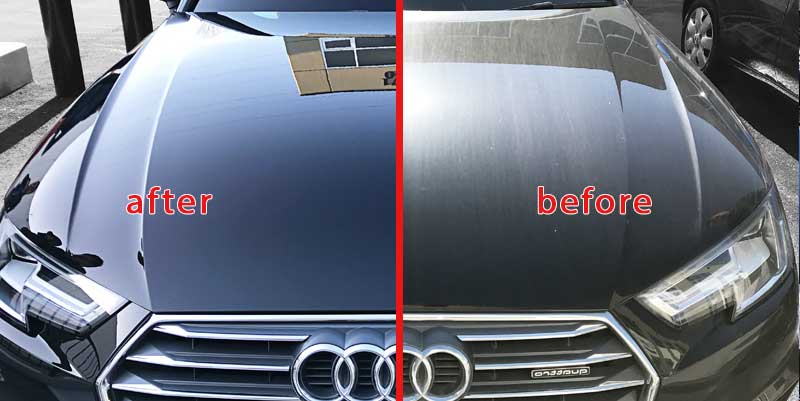High-grade Ceramic Coatings San Jose for a Remarkable End up
Wiki Article
Introducing the Science Behind Ceramic Coatings: Just How Does It Job and Why Is It Above Standard Alternatives?
Ceramic finishes have been acquiring appeal in numerous markets for their exceptional efficiency and toughness. Comprehending exactly how ceramic finishings job and why they exceed conventional options is vital for those looking for to improve the durability and strength of their products.The Chemistry of Ceramic Coatings
In recognizing ceramic layers, delving into the complex chemistry behind their composition is vital for comprehending their capability and resilience. Ceramic coverings are mainly made up of silicon dioxide (SiO2), which forms a solid and protective layer when used to various surfaces. This chemical structure gives extraordinary resistance to warmth, chemicals, and rust, making ceramic layers extremely looked for after for a wide variety of applications.The chemistry behind ceramic finishes involves the formation of covalent bonds in between silicon and oxygen atoms, creating a stiff network that boosts the finishing's sturdiness and sturdiness. In addition, the presence of other elements such as titanium, zirconium, and aluminum more boosts the finishing's homes, supplying boosted hardness and bond to surface areas.
Recognizing the chemical structure of ceramic coverings permits the modification of solutions to suit particular requirements, whether it be for auto, industrial, or domestic functions. By taking advantage of the power of chemistry, ceramic layers remain to lead the way for exceptional protection and performance in various industries.
Advantages of Ceramic Coatings

Another significant benefit of ceramic finishes is their hydrophobic nature. This building triggers water to bead up and roll off the covered surface area, bring dirt and impurities with it. Consequently, ceramic coverings make cleansing and maintaining surface areas much simpler and less taxing. Ceramic coatings use boosted tint and gloss deepness, giving surface areas a vibrant and glossy appearance. Generally, the multitude of advantages provided by ceramic finishings make them a superior alternative compared to standard layer methods.
Just How Ceramic Coatings Bond
Ceramic finishes bond to surfaces via a procedure that entails molecular bond and chemical interactions. When a ceramic covering is applied to a surface area, it creates a strong bond by chemically adhering to the surface area at a molecular degree.Additionally, the chemical communications in between the ceramic finish and the surface even more enhance the bond. ceramic coatings san jose. These communications allow the ceramic finishing to produce a smooth and constant layer externally, offering excellent defense and longevity. Unlike standard finishings that may rest on the surface without fully bonding, ceramic layers produce a permanent bond that is immune to chemicals, UV rays, and extreme environmental problems

Basically, the bonding system of ceramic coverings ensures a resilient and efficient safety layer that outshines conventional coating choices. This superior bond contributes to the resilience, scrape resistance, and durability of ceramic layers, making them a favored selection for different applications.
Toughness of Ceramic Coatings
The phenomenal durability of ceramic coatings originates from their durable molecular bond and chemical interactions with surface areas, ensuring a long lasting protective layer that exceeds standard covering choices. Once applied, ceramic finishes form a strong bond with the substrate, producing a resistant barrier against numerous ecological stressors such as UV radiation, chemicals, and abrasions. This bond is so protected that it can withstand the rigors of everyday usage without weakening or deteriorating swiftly.Unlike typical layers that might weaken over time, ceramic finishes preserve their integrity for an extended duration, supplying resilient protection for the underlying surface. On the whole, the phenomenal longevity of ceramic finishes makes them an exceptional choice for safeguarding a wide array of surfaces in different applications.
Ceramic Coatings Vs. Typical Options
In comparison to traditional finish approaches, ceramic layers use a distinct mix of longevity and safety capabilities that set them apart in numerous surface protection applications. Traditional options such as wax or sealants provide a temporary layer of protection that can wear off rapidly, requiring frequent reapplication. On the various other hand, ceramic coatings create a solid bond with the surface area, producing a semi-permanent or long-term barrier that is highly immune to abrasion, chemicals, UV rays, and severe temperatures.
Furthermore, ceramic coverings provide superior hydrophobic homes contrasted to conventional coverings. The hydrophobic Get More Information nature of ceramic coverings creates water to grain up and roll off the surface, lugging dust and pollutants with it. This self-cleaning effect aids to preserve the surface's sanitation and gloss for extended durations, minimizing the requirement for frequent maintenance.
Furthermore, ceramic finishings have a thicker layer contrasted to traditional choices, giving improved scrape resistance and security against small effects. This longevity makes certain resilient performance and aids preserve the visual allure of the dealt with surface for a prolonged period.
Final Thought
To conclude, the scientific research behind ceramic finishes hinges on their chemical make-up and bonding residential properties, making find more info them exceptional to typical options. The advantages of ceramic coverings consist of increased toughness and protection for surface areas. By recognizing how ceramic layers work and their advantages over typical options, one can make educated choices when taking into consideration finish alternatives for various applications.Unlike standard layers that may sit on the surface without completely bonding, ceramic coatings redirected here create a long-term bond that is immune to chemicals, UV rays, and rough ecological conditions.
The extraordinary long life of ceramic coatings stems from their robust molecular adhesion and chemical interactions with surface areas, ensuring a resilient protective layer that exceeds standard layer alternatives.Unlike traditional finishings that might break down over time, ceramic finishes keep their honesty for an extensive period, supplying resilient security for the underlying surface area.In comparison to traditional covering techniques, ceramic finishes use an unique blend of sturdiness and protective capabilities that set them apart in various surface area defense applications. By recognizing exactly how ceramic finishings work and their advantages over traditional choices, one can make informed choices when taking into consideration finish alternatives for different applications.
Report this wiki page